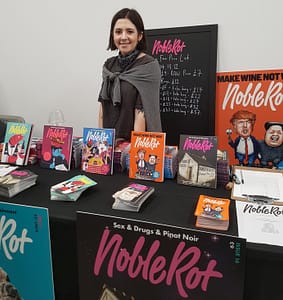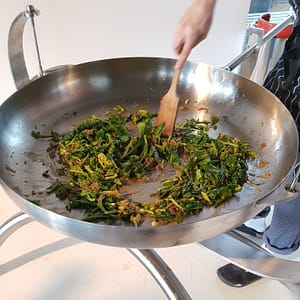London’s Raw fair is over. This wine fair, founded by Isabelle Légeron (now also with meetings in Berlin and New York), is a two day celebration of individual, organic wines with a wide range of exhibitors. But what unifies them is their desire to express their place in their own unique way. Some have a no sulphur approach, while some are more pragmatic to this question.

This year the fair was back at the Strand, in central London, after two years further east. The venue is open and clean with good light, good for wine tasting. Wine bar and restaurant Noble Rot had their stand, and it was possible to savour food of many sorts.

Most of the artisans came from Europe. The bigger wine producing countries like Italy and France, and to a certain extent Spain, had their fair shares of exhibitors. But smaller wine countries were also represented, maybe most surprisingly Romania and the Czech Republic.
Among the more established producers, especially in this context, were Eric Texier (with expressive wines from Côtes du Rhône), the Catalan trio Mas Martinet-Venus la Universal (from Priorat/ Montsant, with increased focus on fruitiness than before), and mainly sparkling wine producers Mas de Serral- Pepe Raventòs and Recaredo-CellerCredo, Frank Cornelissen (who really has become a top Sicilian producer in every respect), not to mention Friulian neighbours Radikon and Gravner with their textbook skin-contact wines.

An opportunity for vignerons like Fabio Bartolomei to communicate directly with their audience
There were many contenders. Aside of the aforementioned ones here producers that I have appreciated for a long time were from France, Dom. Milan (Provence), Dom.de Clovallon (Languedoc); from Italy, Carussin-Bruna Ferro (Piemonte), Corte Sant’Alda (Veneto), 1701 (Franciacorta); Spain, Vinos Ambiz (Gredos/ Madrid); Portugal, both two participants, Quinta da Palmirinha (Minho) and Casa de Mouraz (Dão); Austria, Meinklang (Burgenland).
But not least is this an occasion to be surprised.
Here follow some memorable moments.

Éric Teixier
Chat Fou 2016 (Éric Teixier)
A light entry here: A luscious, inspiring côtes du rhône. Light ruby; red berries, herbal, lightly spiced; juicy, fresh, just a hint of tannins, good acidity. A light, elegant vintage of this wine.

Carles and Montse
Carles Mora Ferrer and his close friend Montse have produced natural wines since 2008; no chemicals, no additives. I chose their cabernet; not pressed, fermented in inox, 20-25 days of maceration. Total sulphites is a mere 4 mg/L.
Cabernet Sauvignon Ánfora 2015 (Clot de les Soleres)
Dark cherry, violet hint; red fruits, blackcurrant, green pepper; structured, good acidity.

Mas Martinet has been a favourite for many years, and maybe the most influential among the Priorat “pioneers” from the 1980’s, thanks to both father Josep Lluís’ teachings, daughter Sara’s and son-in-law René’s consulting and general inspiration through their wines. Sara Pérez, current winemaker, was also in the avant-garde when turning to organics in the early 2000’s. Venus is their side project in Montsant. Here I chose their white Venus, a varietal xarel.lo, fermented 20% with skins and elevated in big barrels. No added sulphite.
Venus Blanc 2014 (Venus la Universal)
Yellow colour; very fresh, citrus, litchi some balsamic; glyceric, creamy and saline. So expressive!

Ivan and Ana Gómez
Bodegas Gratias of Castilla-La Mancha showed some good wines. I chose a field blend of some 20 varieties, many of them in danger of extinction, a crowdfunding project, “gratias to all those people
(‘gratias mecenas’) who believed” in the project, as they say. Fermentation was carried out in small deposits of 5 hectoliters, with whole clusters. The ageing was carried out no the lees, in oak, jars and steel. No clarification or cold stabilization.
¿Y tu de quién eres? 2016 (B. Gratias)
Dark cherry colour; red and dark fruits, a hint of spice; juicy and drinkable, but also with a touch of dryness (from the stems).

Thyge of Bodega Frontío
Here were several surprises at one stand: A new, young producer in the remote Arribes, Castilian area bordering Portugal. Furthermore the man behind the bodega is Danish, Thyge Benned Jensen. I’m learning every year, says Thyge, which is good. But much is already very good: Taste his two-weeks skin-contact Naranjito, another surprise for this region. The variety is doña blanca (even though the label indicates something else).
Naranjito 2017 (B. Frontío)
Yellow with orange tones; mature apples, some peel; quite glyceric, with a supple acidity.

Andrea and Petr Nejedlich of Dobrá
Cuvée Kambrium 2014 (Dobrá Vinice)
A wine from the Podyji national park in Moravia, Czech Republic, a blend of veltlín, ryzlink and sauvignon, as the back label reads. Light colour; gooseberry, white pepper; both round and light, but with good acidity too.
See also an article about Moravian wines tasted in England here.

Mladen Rožanić, jazz fan with creative Istrian wines
Roxanich of Croatian peninsula Istria makes powerful natural wines.
This is a field blend including syrah, cabernet franc, lambrusco, barbera, borgonja, malvasia nera. Bottling went without filtration, after 9 years of aging in big wooden vats and barrels. I like the reds. But the white ones, most often orange in colour, really has an unequalled quality. You can read more about them and another featured wine here.
Ines U Crvenom (in Red) 2008 (Roxanich)
Red, developed colour (towards orange); a volatile feeling, mature red berries, dried fruits and roasted almonds; weighty, packed with fruit, plays with oxidation.

Fernando Paiva and his importer Ricardo Rodrigues of Portuguese Story
Fernando’s wines are marked by the Atlantic influence. His whites are covered several places on this site. This time he showed that the light (light-weight, not light in colour) vinhão can be fascinating when aged too. So that must be the choice.
Quinta da Palmirinha Vinhão 2012 (F. Paiva)
Dark with violet and some red; incredibly fresh, cherry and tint; round, mineral, with integrated acidity. It has an uplifting lightness, a feeling of weightlessness.

Marinella Camerani
Corte Sant’Alda is a well-known Valpolicella producer, mostly in the more classic end of the spectrum. But the wines are thoroughly made, they are good, and they have nothing of the negative characteristics that the area has become known for in many wine circles today. Their classic wines are good. And Marinella presented an intriguing varietal molinara rosé aged in Tuscan amphorae, a vino de tavola with a total of 2 mg sulphur.
Agathe 2016 (Corte Sant’Alda)
Salmon pink; flowers, strawberry and a touch of white pepper; no the palate quite smooth, but also with a surprisingly high acidity.

Lorenzo (left) and Andrea Pendin: Thumbs up for another inspiring meeting
L’Armonia of Vicenza (Veneto), Italy was one of the really great finds at this year’s Raw. Among many good wines I chose this wonderful garganega, from older plants (60-80 years). This is both an early harvest and a late harvest (with some botrytis), then blended. The different harvest times are due to Andrea’s friendship with and inspiration from Sébastien Riffault of Loire. (Read more here.)
Perla 2016 (Tenuta l’Armonia)
Complex aroma of mature apples, nuts, flowers, apricot, towards honey; medium full on the palate, and a salty, mineral aftertaste. Integrated, natural acidity.
Leave a Comment








